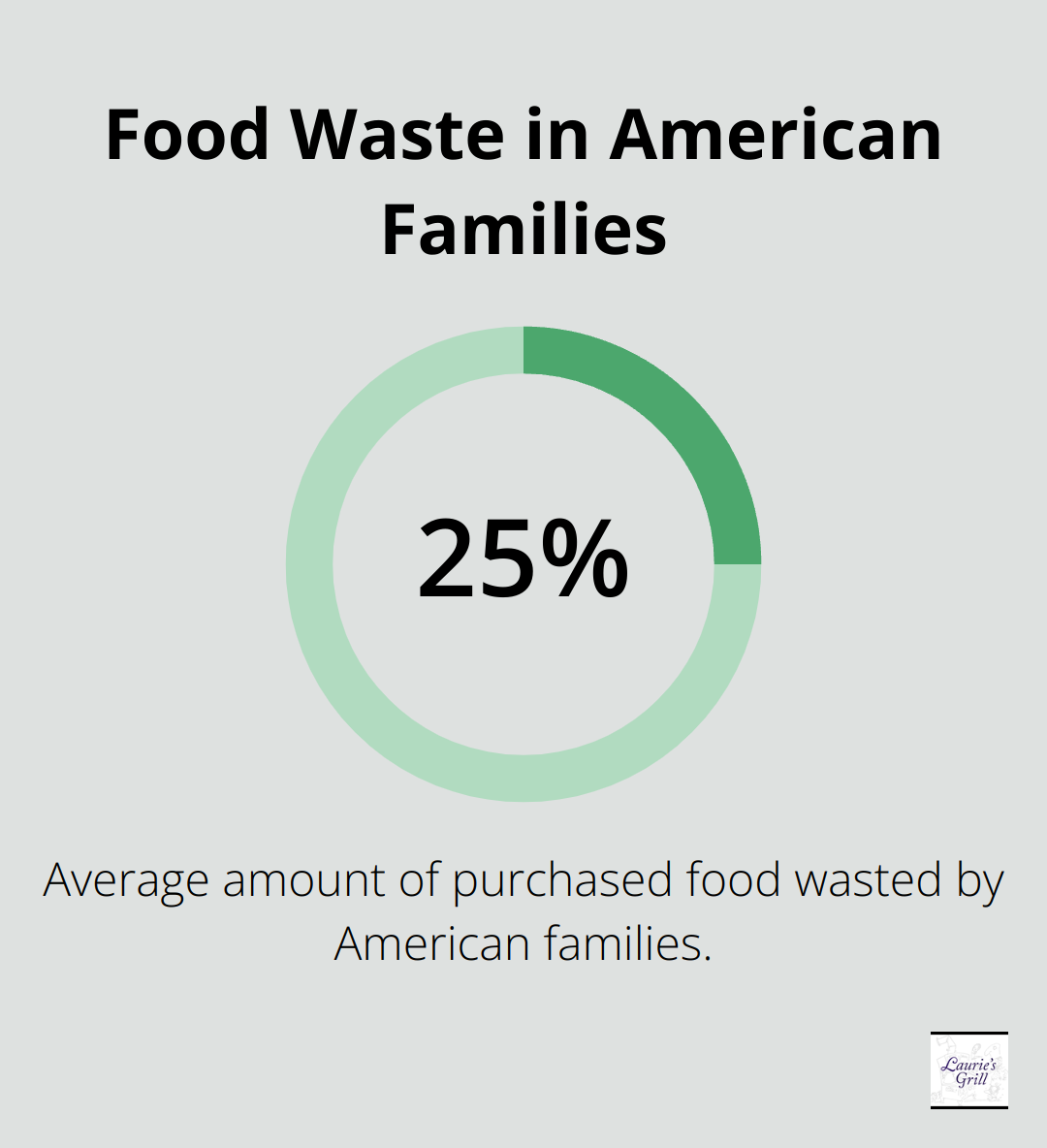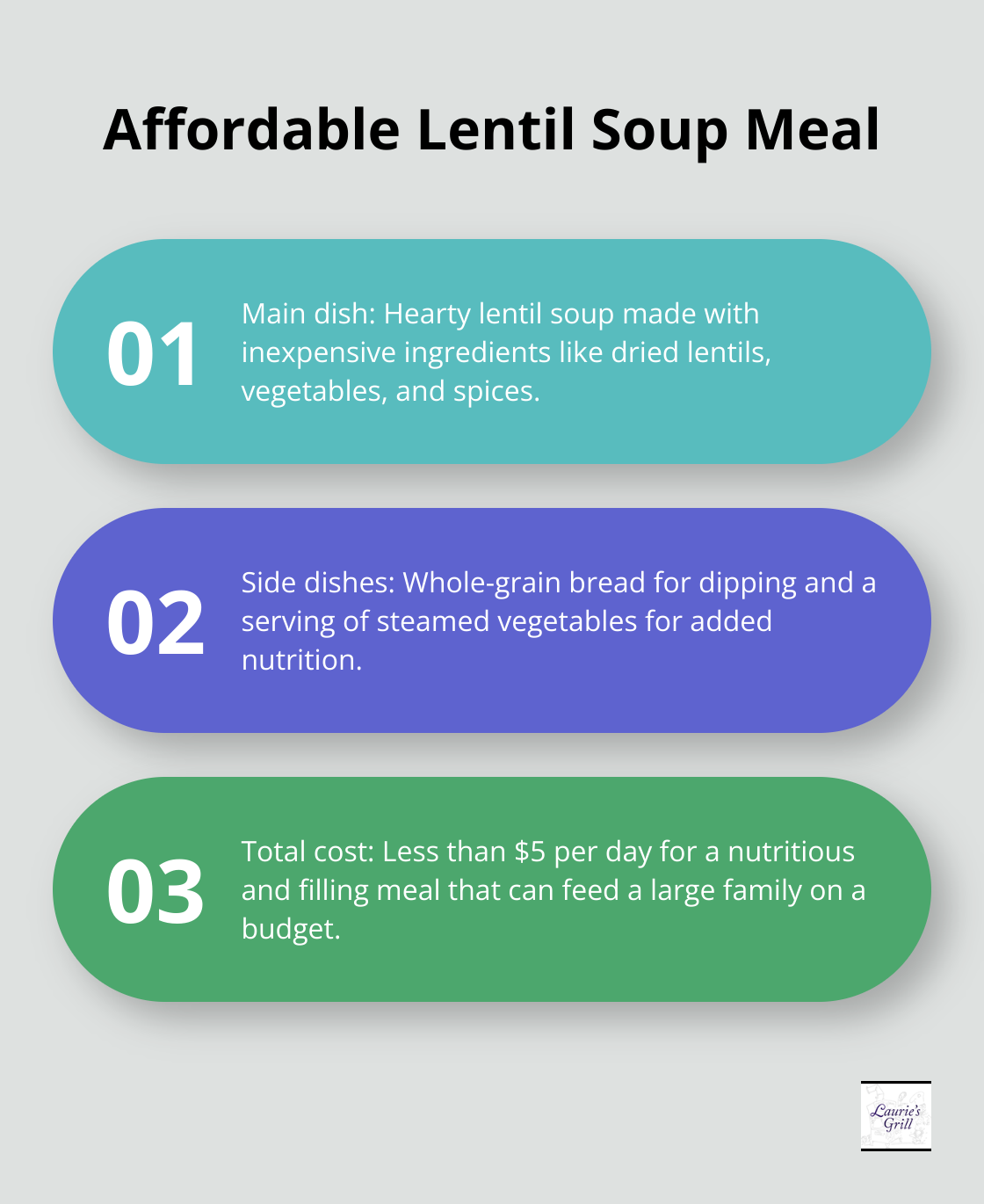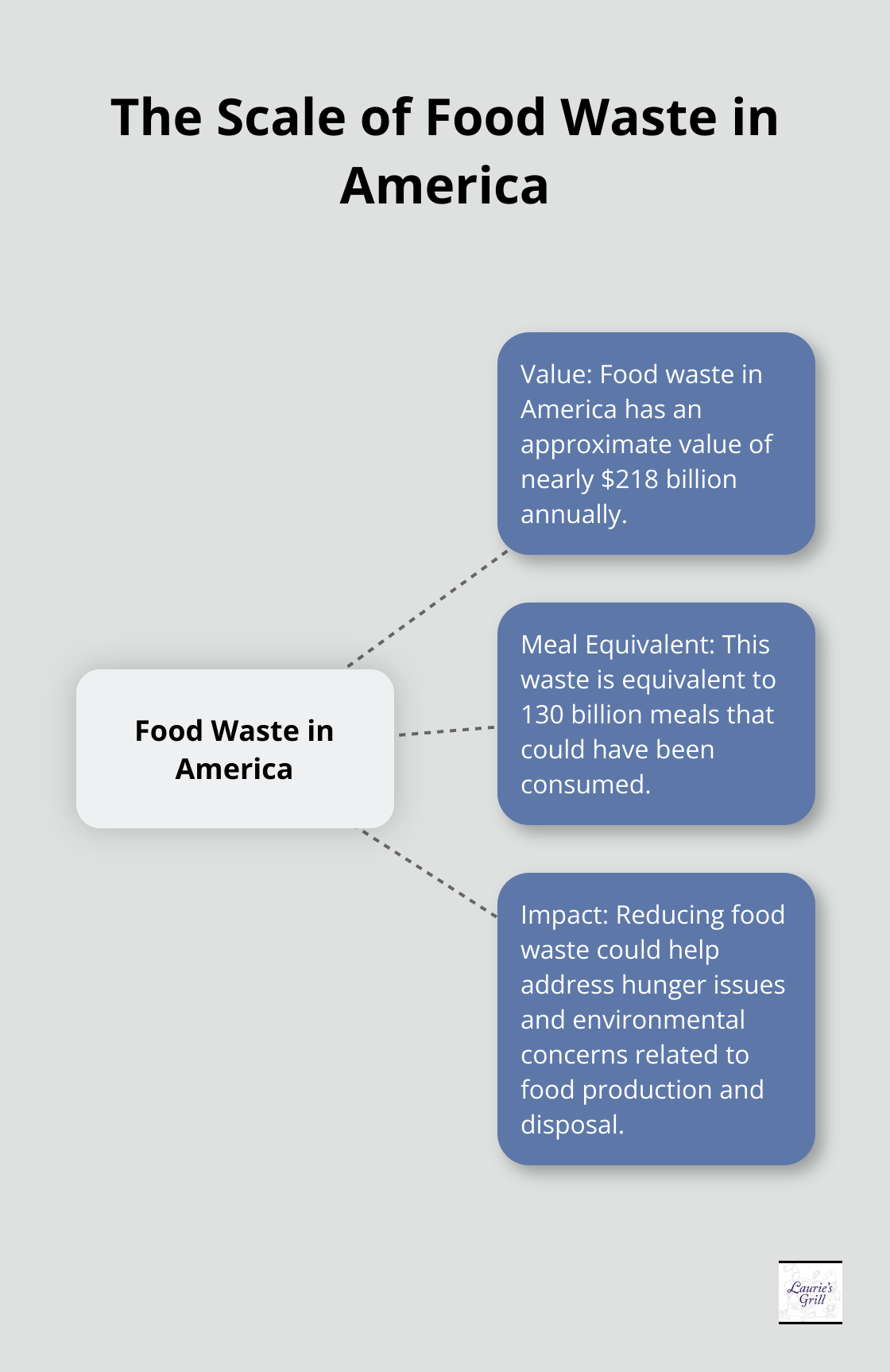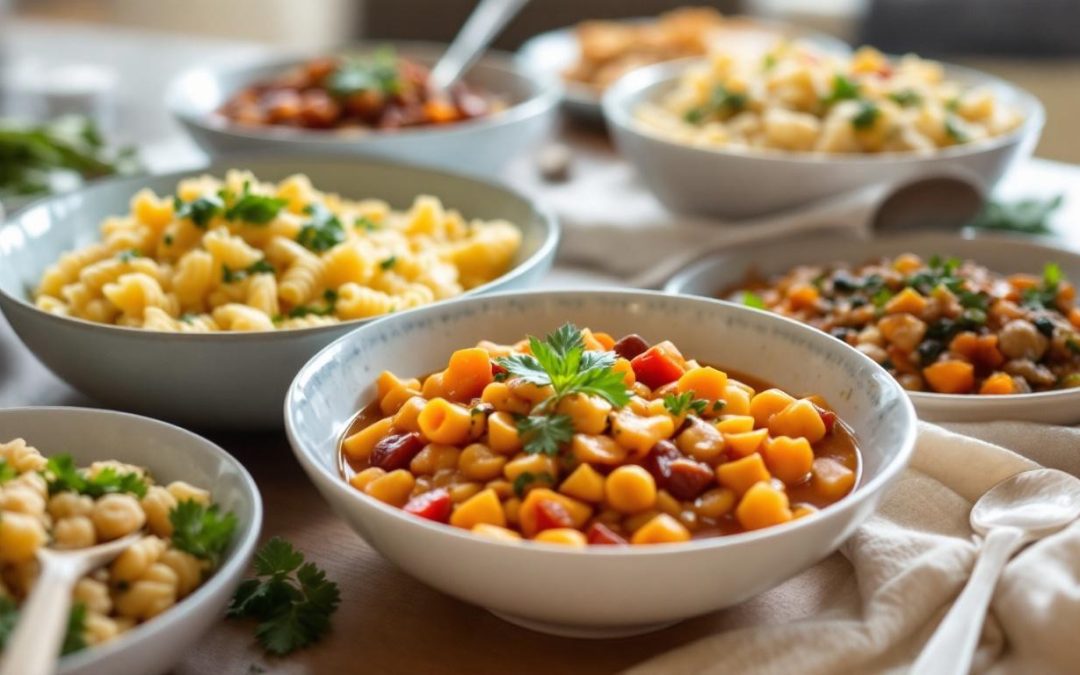At Laurie’s Grill, we know that feeding a large family on a budget can be challenging. That’s why we’ve put together this guide on inexpensive meals for large families.
We’ll share our top strategies for stretching your food budget without sacrificing taste or nutrition. From bulk buying tips to creative leftover ideas, you’ll find practical ways to keep your family well-fed and your wallet happy.
How to Plan Budget-Friendly Meals for Large Families
Planning meals for a large family on a budget requires strategy and creativity. Here are practical tips to help you master budget-friendly meal planning for your large family.
Smart Bulk Buying
Buying in bulk saves money and time. Instead of running to multiple stores or clipping coupons, visit your local wholesale food supplier. However, avoid bulk-buying perishables unless you have a solid plan to use them before they spoil.
A study by the Natural Resources Defense Council found that the average American family wastes about 25% of the food they purchase. To prevent this, create a detailed meal plan before your bulk shopping trip. This way, you’ll know exactly how you’ll use large quantities of ingredients.

Embrace Seasonal Produce
Seasonal fruits and vegetables are not only more flavorful but also more affordable. Create a seasonal produce calendar and plan your meals around what’s abundant each month.
For example, in summer, take advantage of cheap tomatoes, zucchini, and berries. In fall, incorporate squash, apples, and root vegetables into your meals. This approach not only saves money but also introduces variety into your family’s diet.
Meal Prep and Batch Cooking
A few hours each week dedicated to meal prep can save you time and money. A survey by the American Heart Association found that people who meal prep at home eat healthier and spend less on food overall.
Try to cook large batches of versatile ingredients like chicken, ground beef, or beans. You can use these in multiple meals throughout the week. For instance, a large pot of chili can become nachos, baked potatoes, or rice bowls on different days.
Invest in quality food storage containers to keep your prepped meals fresh. The FoodKeeper App (developed by the USDA) provides guidance on how long different foods can be stored safely, helping you maximize your meal prep efforts without compromising on food safety.
Utilize Leftovers Creatively
Don’t let leftovers go to waste. Instead, transform them into new meals. Yesterday’s roast chicken can become today’s chicken salad sandwiches or tomorrow’s chicken soup. This approach not only saves money but also reduces food waste and saves time on busy weeknights.
Plan Around Sales and Coupons
Keep an eye on weekly grocery store ads and plan your meals around what’s on sale. Combine sales with coupons for maximum savings. Many stores now offer digital coupons that you can load directly onto your store loyalty card, making the process even easier.
Now that we’ve covered meal planning strategies, let’s move on to specific affordable and filling main dishes that will satisfy your large family without breaking the bank.
Affordable Family Meals That Satisfy
At Laurie’s Grill, we understand the challenge of feeding a large family on a budget. We’ve compiled our favorite affordable and filling main dishes that will please even the pickiest eaters.
One-Pot Wonders
One-pot meals save time for busy families. They require minimal cleanup and often provide leftovers for the next day. Our go-to is a hearty beef and vegetable stew. Brown some cheap cuts of beef, add potatoes and carrots, and let it simmer. This meal can feed 5 kids and 4 adults for about $16.50.
Another crowd-pleaser is our chicken and rice casserole. Use bone-in chicken thighs (they’re cheaper and more flavorful than breasts), mix with rice, frozen vegetables, and cream of mushroom soup. Bake it all together in one dish for a complete meal with minimal effort.
Soup’s On
Soups and stews excel at stretching your food budget. They fill you up, provide nutrition, and scale up easily to feed a crowd. Our lentil soup is a particular favorite. Paired with whole-grain bread and a side of steamed vegetables, it’s part of a healthy meal that can cost less than $5 a day.

For a protein-packed option, try our bean and ham soup. Use a leftover ham bone or cheap ham hocks for flavor, and bulk it up with dried beans and vegetables. This soup freezes well, so make a big batch and save some for later.
Pasta and Rice Dishes
Pasta and rice form the base of countless budget-friendly meals. Our cheesy baked ziti always hits the spot with families. Use whatever pasta you have on hand, mix with jarred sauce (or make your own with canned tomatoes), add some ground beef if you like, and top with cheese. It’s comfort food that won’t break the bank.
For a rice-based meal, try our burrito bowls. Cook a big pot of rice, add some canned black beans, and top with whatever vegetables you have on hand. Set out salsa, cheese, and sour cream for toppings, and let everyone build their own bowl. It’s an interactive meal that’s both fun and filling.
Flexibility is Key
The secret to affordable family meals is flexibility. Don’t hesitate to substitute ingredients based on what’s on sale or what you have in your pantry. With a little creativity, you can create delicious, satisfying meals that fit your budget.
Now that we’ve covered main dishes, let’s explore how to stretch your dollar even further with affordable side dishes and creative uses for leftovers.
Maximizing Meals with Sides and Leftovers
At Laurie’s Grill, we make the most of every ingredient. Stretching your food budget involves more than just main dishes – it includes smart side dishes and creative use of leftovers. Let’s explore how you can extend your meals without sacrificing flavor or nutrition.
Economical Vegetable Sides
Vegetables don’t have to be expensive to be nutritious. Frozen produce may have more nutrients than fresh, as it is typically picked at peak ripeness. However, some nutrients are lost during processing.
Root vegetables (carrots, potatoes, and onions) typically cost less and last longer. Roast a large batch with olive oil and herbs for an easy side dish that lasts several meals. The USDA’s Economic Research Service found that potatoes provide more nutrients per dollar than most other raw vegetables.
Don’t overlook cabbage – it’s cheap, versatile, and nutrient-rich. Shred it for coleslaw, sauté it as a side, or add it to soups and stews to increase volume.
Homemade Bread and Rolls
The aroma and taste of homemade bread can’t be beaten, and it costs less than you might think. The National Association of Wheat Growers estimates that a homemade loaf costs about $2, compared to $4 or more for a quality store-bought loaf.
Try a simple no-knead bread recipe. Mix flour, yeast, salt, and water, let it rise overnight, and bake. You’ll have fresh, crusty bread with minimal effort. For rolls, use a basic dinner roll recipe. Make a large batch and freeze some for later use.
If time is short, consider a bread machine. While it requires an upfront investment, it can save money long-term by making bread-baking effortless and consistent.
Creative Uses for Leftovers
Food waste in America has an approximate value of nearly $218 billion – the equivalent of 130 billion meals.

Transform leftover roast chicken into chicken salad for sandwiches or a filling for quesadillas. Use leftover vegetables in frittatas or omelets – they’re quick, easy, and suitable for any meal of the day.
Don’t toss stale bread. Make croutons for salads, breadcrumbs for coating, or a bread pudding for dessert. The U.S. Environmental Protection Agency recommends keeping an “eat first” box in your fridge for foods that need to be used soon.
Meal Planning and Prep
Plan your meals in advance to reduce food waste and save money. Create a weekly menu that incorporates leftovers and uses similar ingredients across multiple meals. This approach minimizes the need for extra grocery trips and reduces the likelihood of forgotten items spoiling in the fridge.
Prep ingredients in bulk when you have time. Chop vegetables, cook grains, or prepare proteins that can be used in various dishes throughout the week. This not only saves time but also makes it easier to put together quick meals on busy days.
Smart Storage Solutions
Proper food storage extends the life of your ingredients and leftovers. Invest in quality, airtight containers to keep food fresh longer. Label containers with contents and dates to track freshness easily.
Learn the best storage methods for different types of produce. Some fruits and vegetables (like apples and potatoes) should be stored separately as they can cause others to spoil faster. Understanding these nuances can significantly reduce food waste and stretch your grocery budget further.
Final Thoughts
Feeding a large family on a budget requires smart planning and creative cooking. You can provide nutritious and delicious meals without overspending if you buy in bulk, use seasonal ingredients, and prepare meals in advance. One-pot dishes, hearty soups, and versatile pasta recipes form the foundation of an affordable family meal plan.
Flexibility is the key to success when you cook inexpensive meals for large families. You should substitute ingredients or try new recipes based on what’s available and affordable. We at Laurie’s Grill offer affordable, home-style cooked meals that satisfy both your taste buds and your wallet (visit our website at Laurie’s Grill for more information).
Your journey of budget-friendly family cooking will improve with practice. You will develop a repertoire of go-to recipes and techniques that work for your family. The most important ingredient in any family meal is the love and care you put into it.


Recent Comments